Honor Award
Filling the Gap: A New Productive Land-Building Process for New Orleans, Louisiana
Stefania Mariotti, Student ASLA, University of Toronto
Faculty Advisor: Jane Wolff
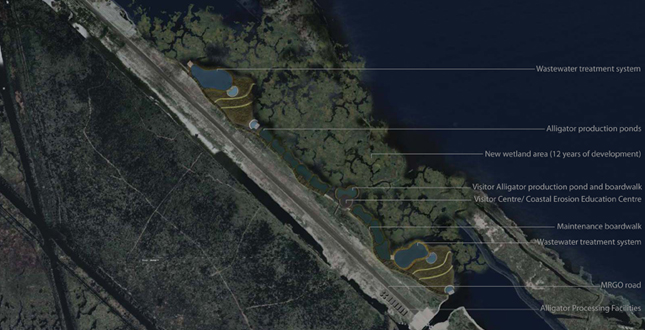 Close Me!
Close Me!This is a proposal to address New Orleans’ problem of coastal erosion to prevent storm surge and its threat existing ever since the construction of the Mississippi River Gulf Outlet (MRGO). It expands the land building program of Louisiana to include habitat, specifically alligators to repopulate the new wetland area and encourage the establishment of vegetation.
Download Hi-Res ImagePhoto: Stefania Mariotti
Photo 1 of 15
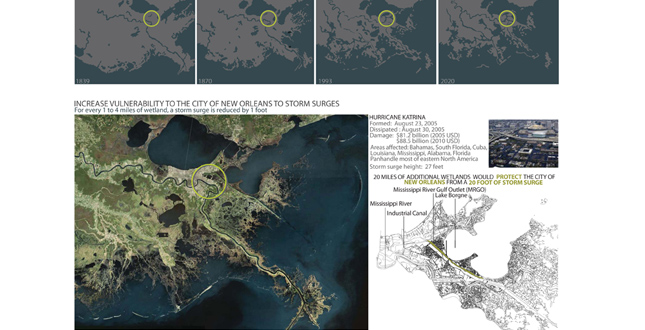 Close Me!
Close Me!Louisiana has been experiencing coastal land loss since the 1800s and it is projected into the future. Coastal land loss is a result of salt water intrusion from the Gulf of Mexico, and dredging canals to ensure they remain navigatable, increasing New Orleans’ vulnerability to storm surges. Therefore, wetland building around the MRGO site would reduce the effects of a 20 foot storm surge.
Download Hi-Res ImagePhoto: Stefania Mariotti
Photo 2 of 15
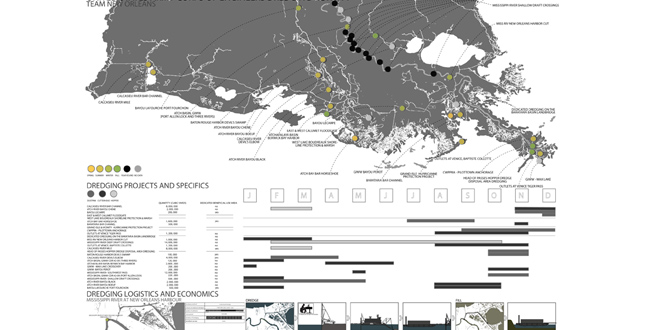 Close Me!
Close Me!In order to maintain waterways, dredging is necessary. This activity reduces the sediment load, essential to the health of wetlands. Occurring throughout the year, this multi-million dollar business is destroying Louisiana’s coastline. A study of the current land building process by the United State Army Corp of Engineers, led to a critical analysis of the current process and in particular the Mississippi River at New Orleans Harbour dredging site.
Download Hi-Res ImagePhoto: Stefania Mariotti
Photo 3 of 15
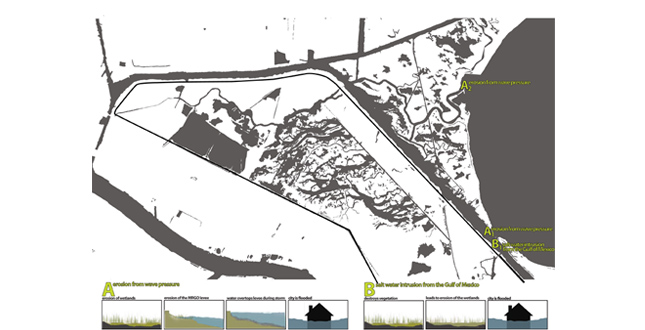 Close Me!
Close Me!The MRGO is a site and situation for disaster. Wind and wave pressure from Lake Borge place pressure on the MRGO levee and salt water intrusion from the Gulf of Mexico destroys vegetation. Both of these forces are resulting in the erosion of wetlands, placing great pressure on levees and threatening New Orleans to flood.
Download Hi-Res ImagePhoto: Stefania Mariotti
Photo 4 of 15
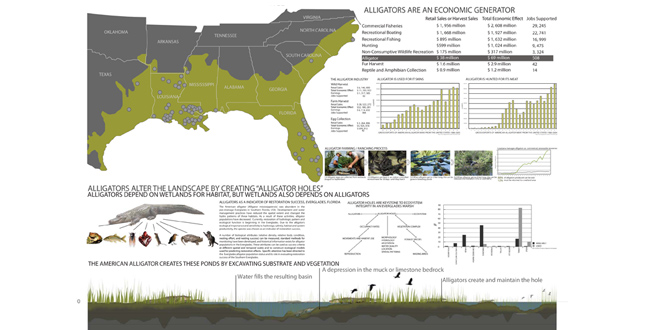 Close Me!
Close Me!The new land building process involves the incorporation of habitat as the catalyst for change, specifically the American Alligator. Used as economic generators, the state of Louisiana also has very specific regulations with their raising. This is because alligators have the ability to alter a landscape by creating alligator holes. These holes become new ecosystems that inevitability attracts other forms of wildlife.
Download Hi-Res ImagePhoto: Stefania Mariotti
Photo 5 of 15
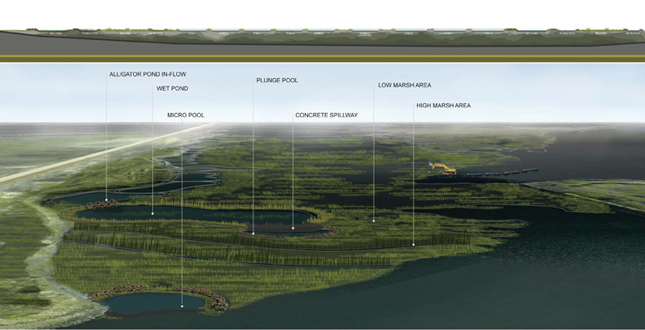 Close Me!
Close Me!This new land building process also involves the incorporate of a wastewater treatment system. This system has been design to treat wastewater from 8 alligator producing ponds. It includes a series of pools, through which wastewater flows through before being treated in the wetland area and finally being released into the canal.
Download Hi-Res ImagePhoto: Stefania Mariotti
Photo 6 of 15
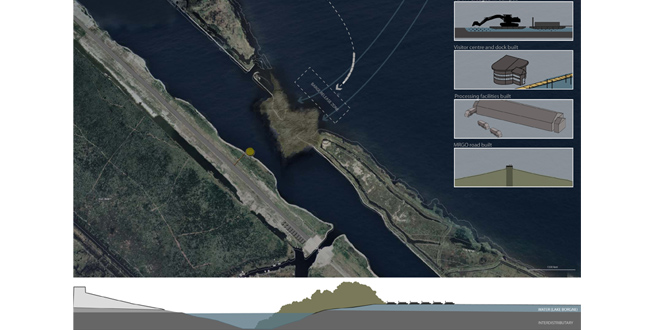 Close Me!
Close Me!Phase 1 of the project involves dumping 1,000,000 cubic yards of sediment dredged from the Mississippi River at New Orleans Harbor site at the interface between Lake Borgne and the MRGO levee. Also in this phase, the alligator production processing facilities and Louisiana Land Building Education centre are built and the MRGO levee is transformed into a road.
Download Hi-Res ImagePhoto: Stefania Mariotti
Photo 7 of 15
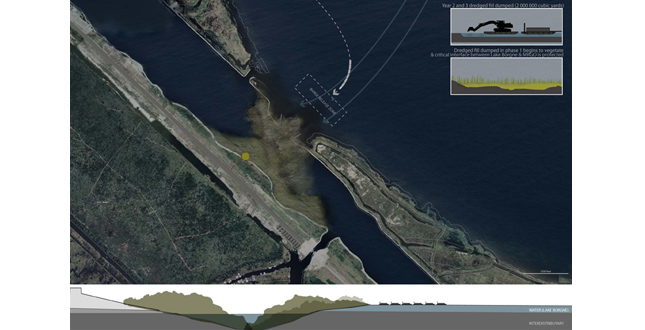 Close Me!
Close Me!Phase 2 of the project involves dumping another load of 1,000,000 cubic of sediment dredged from the Mississippi River at New Orleans Harbor site at the interface of Lake Borgne and the MRGO levee. Also in this phase, vegetation begins to emerge.
Download Hi-Res ImagePhoto: Stefania Mariotti
Photo 8 of 15
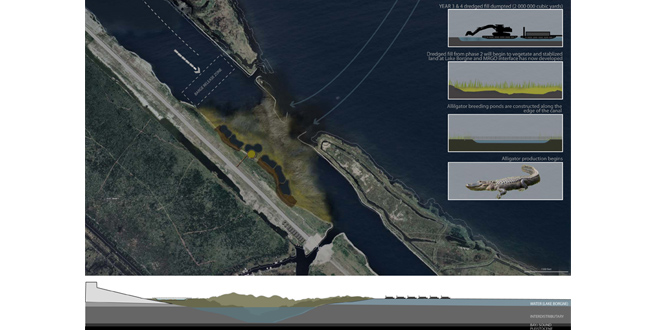 Close Me!
Close Me!Phase 3 of the project involves dumping another load of 1,000,000 cubic yards of sediment dredged from the Mississippi River at New Orleans Harbor site at the interface of Lake Borgne and the MRGO levee. Also in this phase, alligator production ponds are built at the edge of the canal, starting the alligator production process.
Download Hi-Res ImagePhoto: Stefania Mariotti
Photo 9 of 15
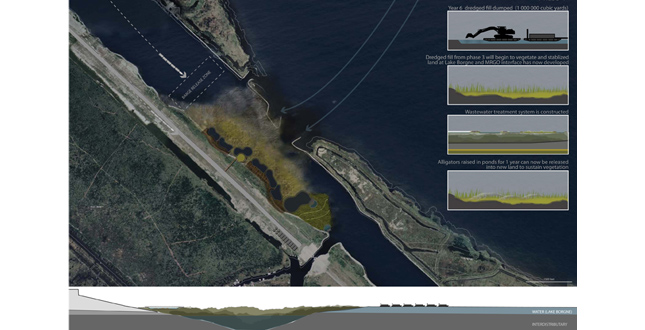 Close Me!
Close Me!Phase 4 of the project involves dumping another load of 1,000,000 cubic yards of sediment dredged from the Mississippi River at New Orleans Harbor site at the interface of Lake Borgne and the MRGO levee. Also in this phase, more vegetation begins to emerge as the wastewater treatment system is constructed. Alligators also raised in the pond for one year can be released into the new wetland area to begin creating a new ecosystem that will protect the city of New Orleans from storm surges.
Download Hi-Res ImagePhoto: Stefania Mariotti
Photo 10 of 15
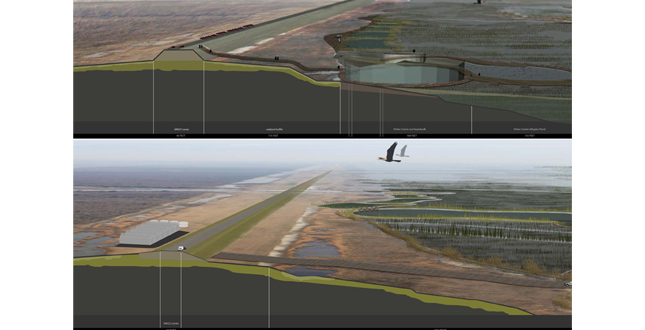 Close Me!
Close Me!In the first image, visitors park along MRGO road and travel through the wetland to the Land Building Education Centre where they will learn about the new process of wetland building in Louisiana and interact with the alligators. In the second image, the processing facilities have smaller temperature controlled tanks in which alligators are grown after they hatch. The waste is then treated in the wastewater system on the other side of the MRGO road. These processing facilities begin the production process of the alligators.
Download Hi-Res ImagePhoto: Stefania Mariotti
Photo 11 of 15
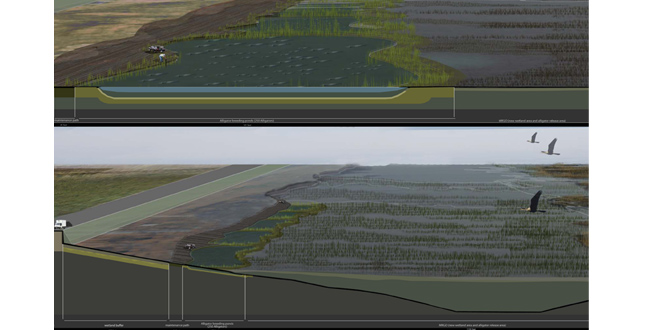 Close Me!
Close Me!In the first image, each alligator production pond contains 250 alligators, maintained by workers on site. Workers travel from pond to pond by driving on the maintenance path, connected to MRGO road (levee). The alligator production ponds and new wetland area will become a recognizable system of wetland reclamation in New Orleans, and greater Louisiana. It will become the known from that will protect the city of New Orleans from storm surges.
Download Hi-Res ImagePhoto: Stefania Mariotti
Photo 12 of 15
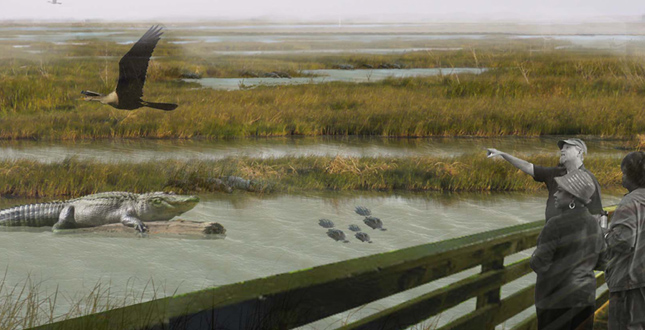 Close Me!
Close Me!The new wetland area attracts different types of animals and habitat.
Download Hi-Res ImagePhoto: Stefania Mariotti
Photo 13 of 15
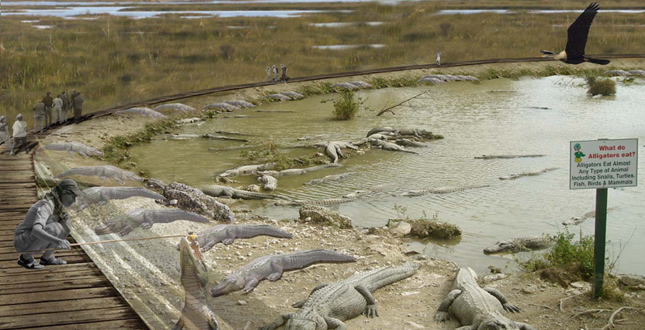 Close Me!
Close Me!The Land Building Education Centre teaches its visitors that new process of wetland development in Louisiana as well as an exciting opportunity to interact with the alligators.
Download Hi-Res ImagePhoto: Stefania Mariotti
Photo 14 of 15
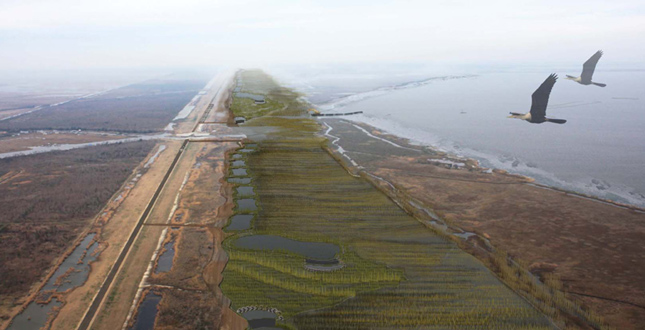 Close Me!
Close Me!This form of wetland building, tested at the Mississippi River Gulf Outlet (MRGO) site, a decommissioned navigation canal will become the known form of wetland reclamation in New Orleans and across Louisiana. This new process incorporating habitat, specifically alligators will not only serve as an economic generator, but also protect the city of New Orleans from storm surges.
Download Hi-Res ImagePhoto: Stefania Mariotti
Photo 15 of 15
Project Statement
This is a proposal to address New Orleans’ problem of coastal erosion to prevent storm surge and its threat existing ever since the construction of the Mississippi River Gulf Outlet (MRGO). It expands the land building program of Louisiana to include habitat, specifically alligators to re-populate the new wetland area and encourage the establishment of vegetation. Essentially, this project will add 20 miles of new wetland area to the MRGO site, reducing the effects of a 20 foot storm surge, comparable to Hurricane Katrina.
Project Narrative
According to Louisiana State geologists, approximately 5, 212 square miles of coast line will be lost by 2100. This rate of coastal land loss is a result of the infrastructure implemented along the Mississippi River to control the level and speed of water to maintain it for navigation as well as the extensive dredging of canals and other waterways in Louisiana. Over time, this infrastructure and dredging activities has decreased the sediment load, vital to the health of wetlands which protect coastal communities from storm surges such as that of Hurricane Katrina. This has resulted in coastal land loss, placing cities such as New Orleans to greater risk of flooding.
Therefore, this thesis project critically analyzes the current land building process associated with dredging activities by the United States Army Corp of Engineers. Currently, as dredging activities take place across the state, at all times of the year, the Army Corp of Engineers, in association with their land building program, dredge waterways and where possible determine a potential beneficial use area were this material can be used to build wetlands. The material is then transported to the area to be dumped. After it is dumped, the Army Corp of Engineers assumes that wetland area will begin to develop. However, as Louisiana’s coast line continues to deplete, placing pressure on the extremely rich fishing industry, wildlife habitat and reliance on wetland area for storm surge protection, this project introduces a new process of wetland (or land) building. This process will incorporate animal habitat, specifically alligators, as the vital element that will assist in the development and stabilization of the new land and vegetation in the Mississippi River Gulf Outlet (MRGO).
The MRGO is a 76 mile channel constructed by the United States Army Corps of Engineers in the mid 20th century that provided a shorter route between the Gulf of Mexico and New Orleans’ inner harbor industrial canal through the Gulf Intercoastal Waterway (GIWW). In 2005, the MRGO channeled Hurricane Katrina’s storm surge into the city of New Orleans, contributing to multiple engineering failures, resulting in catastrophic damage. Since then, the channel has been closed and a permanent storm surge barrier has been constructed. However, salt water intrusion and wave erosion are still contributing to the loss of wetlands surrounding the MRGO, adjacent to the city of New Orleans.
This new land building process involves using the material dredged from a current site, the Mississippi River at New Orleans Harbour and transporting it to the MRGO as its beneficial land use area. Therefore, the sediment will be dredged at this location, transported by barges to the site, where it is estimated that it will take one to two years for vegetation to begin to develop. At this time, alligator processing facilities (for the production of alligators) and the Louisiana Land Building Research Centre are built and the MRGO levee is transformed into a road to gain access to the site. After four years of dumping dredged sediment into the MRGO and as vegetation begins to develop, alligator production ponds are constructed at the site. After the fifth year alligator production begins as they are transported from the production buildings located on site, to the breeding ponds. When the alligators are grown to 4 feet (approximately 1 year), 88% of the alligators can be sold for their meat and hide, while 12 % are released into the new wetland area in the MRGO to help stabilize the land. These percentages have been determined and are enforced by the Louisiana State Wildlife and Fisheries Department to ensure the protection of the keystone specie, while also guaranteeing an economic gain from their production.
This project essentially utilizes this process to develop 20 miles of new wetland area within the MRGO channel, potentially reducing the effects of a 20 foot storm surge. This is comparable to Hurricane Katrina’s 27 foot storm surge height. This new wetland area would not only protect the city, however has the potential to become an education centre for this new land building technique that can be used across Louisiana. It has the potential to educate the citizens of Louisiana of how to protect their coast in building new wetland area, while also ensuring the stability of the fishing industry, protection and enhancement of wildlife, and the development of a new economic wetland building process involving alligators.
Therefore, this new process and form of wetland building in New Orleans, Louisiana will not only protect the city of New Orleans from future storms, but also become the recognizable form of wetland reclamation in Louisiana. It will use landscape as an economic generator to help re-establish the wetlands that have become depleted and introduce habitat for alligators as the crucial and vital component to the land building process in restoration efforts.
Additional Project Credits
Many thanks to Jane Wolff for her patience and guidance during the development of this thesis project. To Elise Shelley and Robert Wright for their practical design advice and support. To Ruth Elsey of the Louisiana State Department of Wildlife and Fisheries for her help with research on alligators and their growing environments. Jennifer Bukovec and Marc Hardiejowski (MLA 2011) for their help with research and detailed design drawings. The Mariotti family for their great support, advice and understanding over the past three years and the MLA class of 2010 for their incredible friendship.





